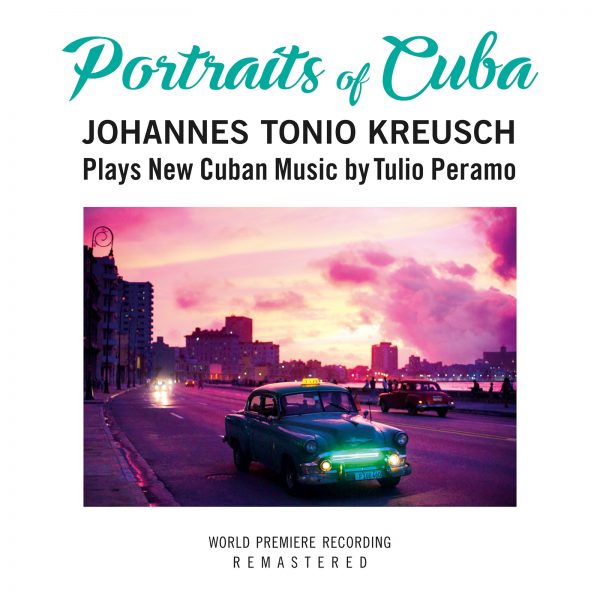CD: Portraits Of Cuba
back to Classical / Jazz / World

Remastered Re-Release 2022
(First published in 2000)
More information / Buy this album at:
https://www.glm.de
What a CD! What a composer! What a guitarist!
Akustik Gitarre
Feat.:
Johannes Tonio Kreusch: guitar
Nan-Maro Babakhanian: Vocals
The Griffin String Quartet
Tracks
Aires De La Tierra (composed 1998)
I. Vegas de Vueltabajo
II Mar
III. Luna de Guamá
IV Salmodia
V. Fiesta
Feat. Nan-Maro Babakhanian (mezzo-soprano)
En Tardes De Lluvia (composed 1999)
I. Preludio (Mágico)
II. Prosas
* Junto al mar (Luminoso)
* Dia (Con garbo)
* Un paseo nocturno
III Murmullos y Danza
Trés Imégenes Cubanas – Homenaja A Caturla En Su 90 Aniversario (composed 1996)
I. Mosso Ritmico
II. Moderato
III Vivio
Feat. The Griffin String Quartet
Canto De Septiembre (composed 1999)
Reviews
Akustik Gitarre: “What a CD! What a composer! What a guitarist!”
Scala: “Music: outstanding / Sound: outstanding
What luck: There are other sounds from Cuba than from the Buena Vista Social Club! Even really outrageous.”
about: Portraits Of Cuba
World First Recording
The compositions on this CD are by the Cuban composer Tulio Peramo. The works were created and dedicated to Johannes Tonio Kreusch. All compositions are via KREUSCH Bros. Publishing/GbR [siehe Rubrik “Noten”] available .
Portraits Of Cuba
In 1994 I met Tulio Peramo for the first time during the guitar festival in Havana. On my concert tours I always try to explore the music scene of the country and meet the composers living there. In the process, you will encounter exciting personalities whose work must be discovered and made known.
In 1994, when I was 23 at the time, I was of course very honoured when Tulio asked me after my concert if I wanted to premiere the revised version of his first guitar concerto “Tientos y Cantos” the following year. Since that time we work together very intensively and have also become good friends over the years.
The first piece he dedicated to me was the guitar concerto “Tres Imégenes Cubanas”, which can be heard in the version for string quartet on the CD and which I premiered at the guitar festival in Havana in 1998 at the invitation of Brouwer. But I consider the song cycle “Aires de la Tierra” to be at the heart of our collaboration. Tulio wrote this cycle for the concert I gave with the New York mezzo-soprano Nan-Maro Babakahnian at Carnegie Recital Hall in March 1999. It is a very personal work of the composer, who was trained as a singer.
The CD contains only first recording! They are all works dedicated to me, which were created in the joint creative process. I stress this because it is very important for me to be involved in the process of creating the composition. Especially for composers who do not play the guitar themselves, it is important to know the performer as an active companion during the creation of the composition at his side.
When I meet a composer whose music touches me, I also try to find out what the strengths, the peculiarities and the weak sides of this person are. In the same way, I challenge the composer to deal with the weaknesses and strengths of my game and to find something new together. A work is to be created with which both can identify!
Tulio is a great connoisseur of Cuban culture. In my view, the works, which are shaped by the Cuban tradition, are its strongest. “Portraits of Cuba” is not only music by Tulio Peramo, but also music of Cuba! The idea for the title came to me because – instead of postcards or pictures – I always brought a new composition by Tulio Peramo from my trips to Cuba.
The music of Tulio Peramo is still largely unknown, so new for many. Another aspect that, in my view, justifies the subtitle “New Cuban Music” is the fact that Tulio belongs to the young generation of cuban composers, who are rethinking their traditional roots. In his music, the street dances and rhythms of Cuba and the world-famous “Son” mix with new musical ideas. For example, “Fiesta”, the last piece of the song cycle, is in the tango-conga rhythm, which used to be used in cuban comedy performances. For the lyrics Tulio uses the long-forgotten dialect “Bozal”, which was spoken by the black slaves in Cuba in the 18/19th century.
(From an interview with Johannes Tonio Kreusch in the magazine “Gitarre Aktuell”)